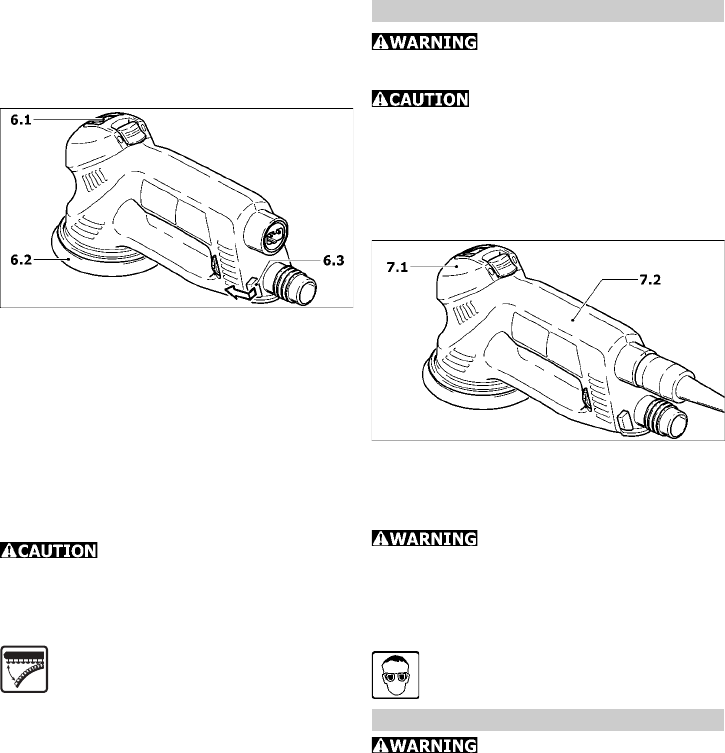
5
Choice and installation of sanding
pads
Choice of sanding pad
The tool can be fitted with three sanding pads
of different hardnesses depending on the
surface to be sanded.
Hard: Coarse sanding on surfaces, sanding at
edges.
Soft: Universal use for coarse and fine sanding
for flat and curved surfaces.
Super-soft: Fine sanding on formed parts,
curves, radii. Do not use on edges!
Installation
The FastFix system enables tool-free
replacement of the sanding pad:
- Set the switch (6.1) to the right for the Rotex
rotary motion,
- Press spindle stop (6.3), direction of
movement first to the side, then forwards,
- Turn the fitted sanding disk (6.2) from the
spindle (right-handed thread),
- Keep the spindle stop pressed and screw on
the new sanding pad (in doing so, make sure
that the rubber collar (8.1) is correctly fitted!),
- Let go of the spindle stop.
Actuate the spindle stop only
when the drive spindle is stationary. Do not
switch on the motor when the spindle stop is
pressed in.
Attaching the abrasive
Stickfix is a hook-and-loop fastening
system. Stickfix sanding pads allow the
use of self-adhesive hook-and-loop
abrasives such as Stickfix sandpapers
and sanding cloths.
Simply press the abrasive onto the sanding pad
(6.2) and pull it off again after use.
Please note: Use only abrasives with an
undamaged Stickfix hook-and-loop coating.
Before use, check that the coating has not been
damaged by improper use (such as over-
heating).
Securing polishing attachments
To prevent damage, use PoliStick polishing
attachments (sponges, felt, lambswool
bonnets) only with the special polishing pad
fitted on the tool instead of a sanding pad. Like
StickFix abrasives, the PoliStick polishing
attachments are simply pressed onto the
polishing pad and pulled off after use.
Working with the tool
Always secure the workpiece in
such a manner that it cannot move while being
sanded.
Never overload the tool by using
too much pressure! The best sanding results
are achieved when applying moderate pressure.
Sanding performance and quality depend
primarily on the choice of the right abrasive.
For safe guidance, hold the tool with one hand
on the motor housing (7.2) and the other hand
on the gear head (7.1).
Tables A and B show the settings we
recommend for different sanding and polishing
work.
Metalworking
Observe the following safety
precautions when working on metals:
• Pre-connect a residual current circuit-breaker.
• Connect the tool to a suitable dust extractor.
• Regularly clear out any dust accumulations in
the motor housing.
• Wear protective goggles.
Maintenance and care
All maintenance or repair work
requiring the motor housing to be opened must
be carried out only by an authorized service
workshop. Maintenance or repair work carried
out by an unauthorized person can lead to the
incorrect connection of the wiring or other


















